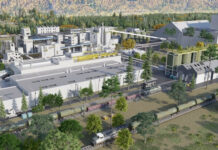By Anne Cosgrove
From the January / February 2023 Issue
Foreign direct investment continues to enter Canada at a steady pace. In Q3 2022, FDI inflows reached $18.7 billion, 31% greater than the five-year quarterly average and on par with the investment levels from the first two quarters of 2022. By investment type, Reinvested Earnings contributed the lion’s share of FDI inflows, capturing 72.2% of the total with $13.5 billion, an increase of 18.1% compared to the previous quarter.
The United States remains the biggest single source of investment in Q3 2022, at 37.1%. Over 50% of FDI inflows came from four European countries: Switzerland (18.4%), the Netherlands (16.9%), France (8.7%), and Luxembourg (7.5%) together account for over half of FDI inflows for the third quarter of 2022.
Here is a sampling of regions across Canada welcoming businesses from around the world, while committed to supporting growth of homegrown firms.

Alberta: Connected To Your Markets
What do companies like Amazon, GoodLeaf Farms, and De Havilland have in common? They’re all proud to call the province of Alberta home.
Located in western Canada with a population of nearly five million, Alberta is the fourth largest province in the country. Renewable energy, food processing, aviation, and advanced manufacturing companies are taking advantage of Alberta’s diverse innovation expertise to build a more sustainable and equitable world.
Albertans enjoy high average wages, the lowest income tax brackets in Canada, low utility costs, and low housing prices. Quality public healthcare and education systems allow business owners to build their wealth while enjoying the communities they work and live in.
Not only is it affordable to live in Alberta, but commercial real estate is reasonably priced. Edmonton and Calgary, two major urban centers, have plenty of quality commercial space available and the lowest downtown office Class A rental rates in the country. Rural communities across the province boast innovative manufacturing, food processing, energy, and logistics facilities that can scale to meet a company’s ambitious growth plans.
Investment-ready sites in rural Alberta. In the East-Central region of Alberta in St. Paul County sits a 35-acre property with a state-of-the-art, 30,000-square-foot facility. This unique facility has Canadian Food Inspection Agency approval and is situated on an industrial lot that offers convenient access to a highway system that easily connects you to Canadian and international markets.
Just off the Queen Elizabeth II Highway, in the CANAMEX Trade Corridor, Junction 42 presents an ideal location to join the renewable energy, hydrogen and electric vehicle fueling infrastructure development, and sustainable indoor farming sectors. The region offers access to technology validation and emerging expertise through Red Deer’s Energy Innovation Centre and Manufacturing Centre of Excellence. Research is focused on traditional and alternative energy use, artificial intelligence, machine learning, and internet of things (IoT) applications to support complex power, control, and energy systems.
Alberta’s greatest asset is its people. Not only is Alberta’s population growing at a faster rate than any other province, but it’s also the youngest in Canada, diverse, and highly educated. In fact, Alberta has the most engineers per capita in the country and the third highest percentage of landed immigrants in the working age population. As home to almost 100,000 tech workers, this number continues to grow thanks to the province’s excellent post-secondary institutions specializing in energy, computer science, engineering, and medical sciences.
Albertans are working hard to drive impact and create positive change to a sustainable low carbon global economy. With industry expertise and innovation across supply chains to a diverse workforce that is addressing today’s challenges, Alberta’s energy sector is supporting the global low carbon transformation.
Make your ambitions a reality with highly educated labor, a low cost of doing business, market access and infrastructure, government incentives, and a superior quality of life.
Visit investalberta.ca for more information.

Canada’s Fastest Growing EV Supply Chain: Windsor-Essex, Ontario
The Windsor-Essex region is situated at the heart of the richest consumer market in the world, with over 200 million people located within a 13-hour drive. The region is directly linked to the busiest commercial Canada-United States border crossing, handling approximately one third of all Canada-U.S. trade of nearly $750 million US daily. The region’s prime location, quality of life, great economic prospects, and highly skilled workforce make it an easy decision when considering an ideal place to start or expand your business.
Building on the region’s rich history in the development and production of the automobile, Windsor-Essex is now leading the next-generation automotive industry as Canada’s primary integrated supply chain for the development and production of connected, autonomous, and electric vehicles (EVs).
Windsor-Essex has been successful in attracting billions of dollars in investment over the past few years including the $4.1 billon U.S. joint venture between Stellantis N.V. and LG Energy Solution (LGES) to build the NextStar Energy Inc. electric vehicle battery plant. This is the first large-scale, domestic electric vehicle battery manufacturing facility in Canada. Construction on the 4.5-million square-foot plant is well underway with a targeted completion in the first quarter of 2024. This project has been the catalyst for the creation of a strong battery supply chain across the Windsor-Essex region.
Fast on the heels of the NextStar announcement came the deal to see South Korean manufacturer Dongshin Motech (operating in Canada as DS C&K Inc.) build a $45 million U.S. EV supply plant in Windsor, its first in North America. The plant will manufacture highly specialized aluminum casings for EV batteries and will employ approximately 300 people. Together, these two facilities will employ approximately 3,000 people in the region.
As part of a $2.8 billion U.S. investment, Stellantis also announced retooling of the Windsor Assembly Plant to produce EVs and a 100,000-square-foot electric battery lab that will be added to the company’s Automotive Research and Development Centre. The new battery lab will be central to Stellantis’ R&D operations in North America and serve the company’s worldwide needs for technology, process, and product development.
Further adding to Windsor-Essex’s growing battery technology cluster is the Flex-Ion Battery and Innovation Centre (a division of Flex-n-Gate). It will be the company’s lead R&D facility for battery design, development, and testing. The company has invested $15 million US into the facility and equipment to become a premier battery testing location.
Windsor-Essex is home to Canada’s largest publicly accessible virtual reality (VR) CAVE as well as the Canadian Automobility Hub. The VR CAVE serves as a commercialization tool to support connected, autonomous, and electric vehicle development through virtual reality and prototyping. Virtual reality provides many opportunities to aid in product development, including simulation, skills training, and collaboration.
A first for Canada, the Canadian Automobility Hub offers a suite of resources and services, including a state-of-the-art ramp-up factory, to enable and support a network of innovative entrepreneurs and businesses interested in advancing the market for electric, zero-emission, as well as connected and automated vehicle technology and infrastructure.
Windsor-Essex, Ont. is a place for growth and opportunity. The region is on track to be the battery capital of Canada and most likely North America. The current developments and investments in the region’s expanding EV supply chain is a direct indication that businesses and individuals in the EV industry should set their sights on Windsor-Essex, Ont., Canada.
Visit investwindsoressex.com for more information.















![[VIDEO] Get More for Your Business in Ardmore. Oklahoma](https://businessfacilities.com/wp-content/uploads/2024/02/maxresdefault-324x160.jpg)
